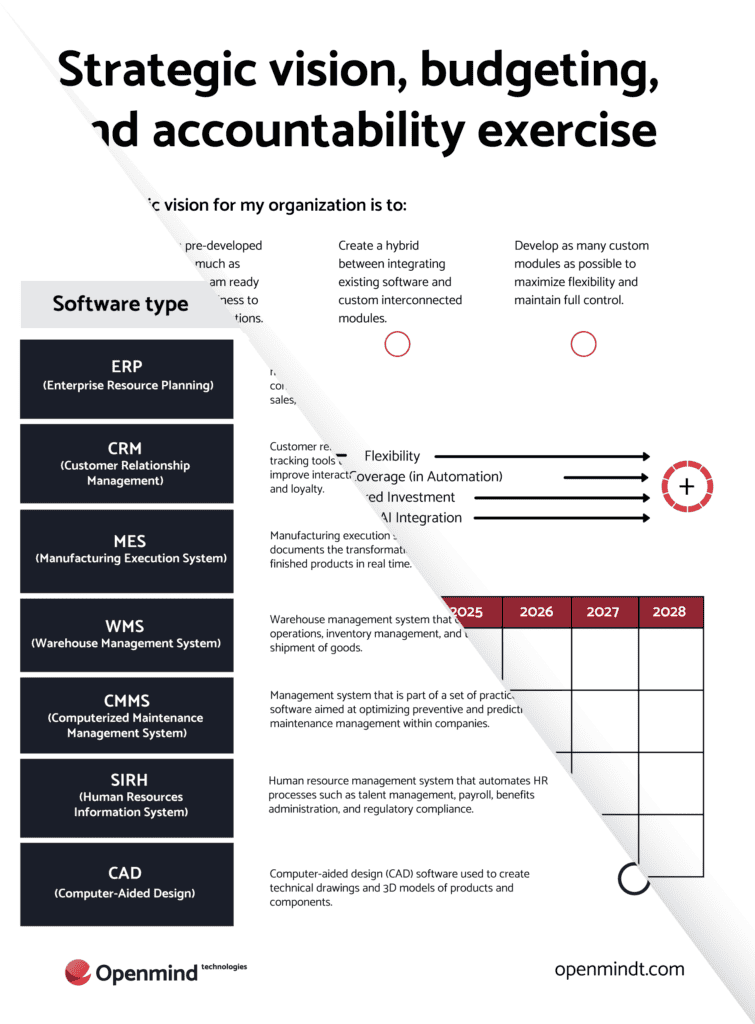Elevate your manufacturing strategy with key resources
Download our Technological Maturity Self-Assessment & Strategic Vision Exercise tools to assess your software ecosystem profile and to plan for future growth.

Managing production capacity is crucial for any modern business, directly impacting profitability. Monitoring and increasing production capacity should be a priority objective. In this article, we explore how a Manufacturing Execution System (MES) can significantly boost your production capacity by leveraging process automation, real-time data, and efficient inventory management. Discover the benefits and strategies to maximize your production potential with MES, enhancing manufacturing efficiency and production optimization.

Production capacity is a critical KPI for measuring the efficiency of a company’s structures and processes. It represents the maximum output achievable with available resources over a specific period. By closely monitoring production capacity, businesses can assess their operational performance and respond to economic fluctuations—identifying slowdowns with decreasing rates or expansions with increasing rates. Leveraging MES software benefits can optimize this capacity, driving productivity and profitability through enhanced process automation and real-time data insights.

Analyzing production capacity as a key performance indicator (KPI) offers a clear understanding of resource utilization and facilitates production adjustments without increasing costs. When production capacity is transparent and accessible, it’s easier to identify necessary adjustments to meet market demands. Ensuring production capacity aligns with demand is crucial. Overcapacity leads to underutilization, while undercapacity results in an inability to meet customer needs. Maintaining optimal production capacity is essential for maximizing efficiency and profitability. Implementing a Manufacturing Execution System (MES) can help achieve this balance through real-time data and process automation, contributing to overall operational performance.

Companies have various means to increase production capacity. However, of all the existing solutions, the most workable is to optimize the production process by using all available resources. Firstly, all the currently untapped potential must be taken into account. Once this exercise is done, you will gain flexibility, and your production line will be maximized.
To undergo this process, we’ve identified three factors that we think are important to help you achieve maximum production potential.

The technologies available today definitely create opportunities for businesses. When it comes to production capacity, the key is having a 3600 solution in order to maintain control of all the elements that influence production. The M.E.S. is a tool that allows you to optimize the efficiency of implemented systems in real time to allow you to adapt to demand.
Now, let’s take a closer look at what an M.E.S. does for production capacity. Here, we’ll compare the efficiency of a production line with and without an M.E.S., while considering the three factors mentioned above.

Download our Technological Maturity Self-Assessment & Strategic Vision Exercise tools to assess your software ecosystem profile and to plan for future growth.

The implementation of an M.E.S. makes it possible to measure and improve the efficiency and overall performance of a production line by optimizing its planning. It also allows the activation and use of real-time company data to improve the production process.
To gain a better understanding, we will analyze three elements that impact production capacity, namely process automation, reporting, and inventory and flows of raw materials.

Process automation consists of transferring certain repetitive tasks (with low added value) carried out manually to a computerized system. The more a system is automated, the higher the production capacity.
Without an M.E.S.: Automation is Incomplete
Automation is possible without an M.E.S. However, in that case, machine automation will not be exploited to its full potential. This is due to the fact that machines are not able to communicate with the rest of the production line, which considerably limits the impact on production capacity.
With an M.E.S.: Integration with the System in Place is Made Possible
Automation is enhanced when an MES is implemented because it connects machines and other tools in the production chain, like, for example, the ERP. Information in the system thus generates greater production capacity through better equipment monitoring.

Before thinking about increasing production capacity, it’s important to understand it first, and this is exactly what reporting does. Indeed, it allows data to be materialized and transformed into useable information.
Without an M.E.S. : Less Information is Available
The absence of an M.E.S. can lead to an erroneous reading of production and leave certain production potentials unexploited. The measurement of production capacity is less precise.
With an M.E.S.: Provides a Complete View of Production
Thanks to an accurate and complete reading of production capacity, a company can benefit from a better view of possible optimizations. Ultimately, it will be able to increase its production capacity after identifying the flaws in the production chain, whether they are related to machines or human resources.

It’s unfortunate for a business when the quantity of raw materials can’t keep pace with demand. This is why proper management of inventory and material flow ensures consistent production even when demands fluctuate.
Without an M.E.S.: Flexibility Will Be Limited
A production line that operates without an M.E.S. is not able to quickly adapt to fluctuating demands which can affect business performance.
With an M.E.S.: Benefit from Increased Flexibility
A production line that uses an M.E.S. will be able to adapt more easily in real time and better respond to requests. Inventory management will be greatly optimized, and the flow of raw materials will be optimal.
While operating without a Manufacturing Execution System (MES) is possible, modern companies can significantly benefit from investing in this tool to stay competitive. MES is essential in Industry 4.0, offering the intelligence to enhance production capacity and boost profitability. By integrating MES, businesses can streamline operations, improve efficiency, and respond effectively to market demands, ensuring sustained growth and success. Embrace the benefits of MES to optimize production processes and maintain a competitive edge in the evolving industrial landscape.
For an in-depth understanding of essential KPIs to monitor with a Manufacturing Execution System, read our article on Ten Key Performance Indicators to Monitor Using a MES.
Subscribe to receive our exclusive updates directly to your email.

Tell us more about your needs so that we can better route your project to our specific SWAT team.
1
During the brainstorming phase, we work with you to identify potential solutions to your business challenges to generate the technology response that aligns with your business objectives.
2
Through our requirements gathering process, we work closely with you to define and prioritize your needs, ensuring that our solutions are tailored to meet your specific requirements.
3
This phase marks the beginning of our partnership. We’ll finalize the project plan and establish clear communication channels to ensure a smooth and successful project execution.